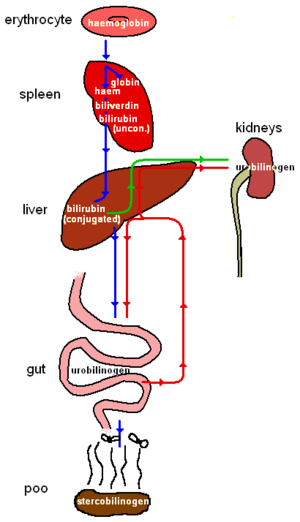Bilirubin
Jump to navigation
Jump to search
You should know this for understanding jaundice, and metabolism of bilirubin is a process that begins in the blood, with the...
- Erythrocytes - Contain haemoglobin. Run around the body in the blood until passing into the spleen…
- Spleen - Breaks up the old blood cells, cracking apart the haemoglobin to produce haem, then biliverdin and then unconjugated bilirubin. It then chucks the whole lot out into the portal vein which passes to the liver…
- Liver - It gets conjugated (and so becomes water soluble). The conjugated bilirubin then passes out into the gut…
- Gut - In the gut, jolly old conjugated bilirubin is converted by bacteria into urobilinogen. Some leaves in urine, much is reabsorbed into the enterohepatic circulation then a large amount of it is oxidised to stercobilinogen, and excreted in the faeces…
- Faeces - Stercobilinogen is the main pigment in poo. That is about it really except…
- Urine - A small amount of conjugated bilirubin is absorbed straight from the liver. If the bile duct is blocked then a whole lot more goes into the urine, making it darker. A tiny amount of urobilinogen is absorbed from the gut. In early or recovering hepatitis, this results in pre-formed stercobilinogen appearing in the urine in excess as urobilinogen. Once the biliary obstruction is established this levels drops – so it is a sensitive marker of early liver damage. Confused? Me too.
- Enterohepatic Circulation - The urobilinogen is reabsorbed, and travels back through the liver and down the bile duct again. This returns the cholic acid and chenodeoxycholic acid to the liver, enhancing bile secretion.
